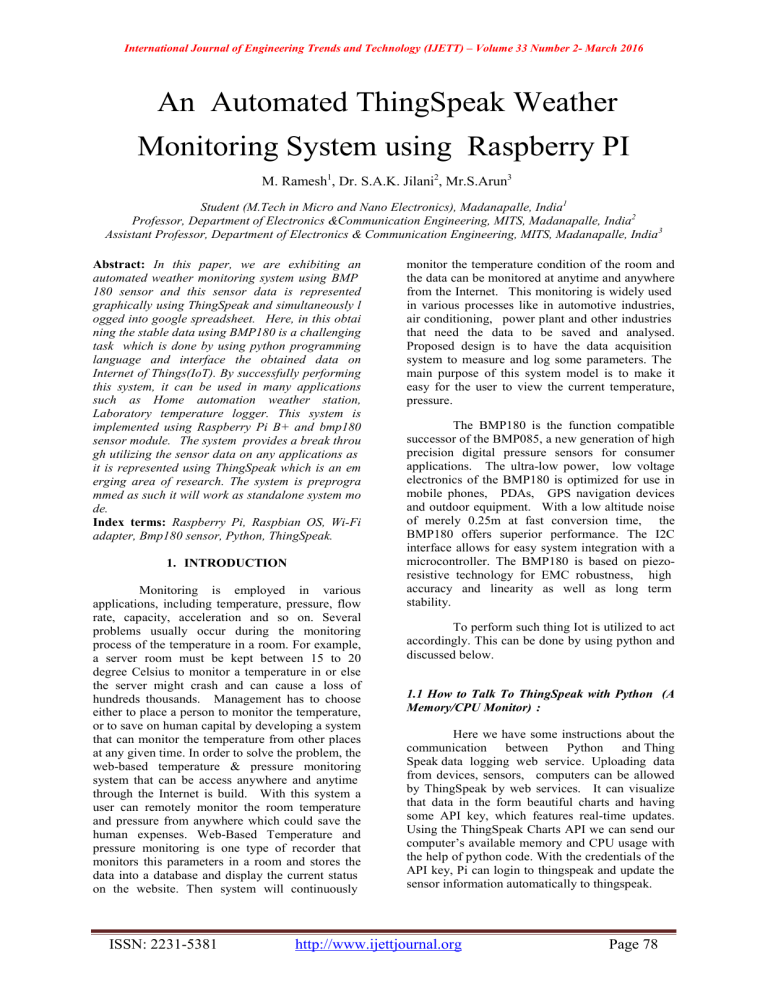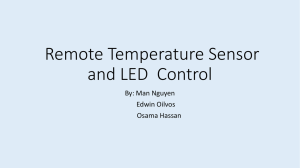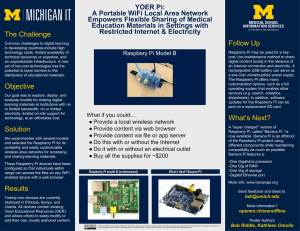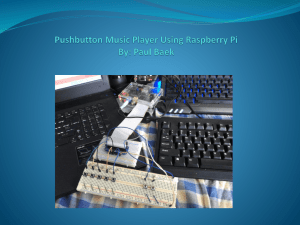An Automated ThingSpeak Weather Monitoring System using Raspberry PI

International Journal of Engineering Trends and Technology (IJETT) – Volume 33 Number 2- March 2016
An Automated ThingSpeak Weather
Monitoring System using Raspberry PI
M. Ramesh
1
, Dr. S.A.K. Jilani
2
, Mr.S.Arun
3
Student (M.Tech in Micro and Nano Electronics), Madanapalle, India
1
Professor, Department of Electronics &Communication Engineering, MITS, Madanapalle, India
2
Assistant Professor, Department of Electronics & Communication Engineering, MITS, Madanapalle, India
3
Abstract: In this paper, we are exhibiting an automated weather monitoring system using BMP
180 sensor and this sensor data is represented graphically using ThingSpeak and simultaneously l ogged into google spreadsheet.
Here, in this obtai ning the stable data using BMP180 is a challenging task which is done by using python programming language and interface the obtained data on
Internet of Things(IoT). By successfully performing this system, it can be used in many applications such as Home automation weather station,
Laboratory temperature logger. This system is implemented using Raspberry Pi B+ and bmp180 sensor module.
The system provides a break throu gh utilizing the sensor data on any applications as it is represented using ThingSpeak which is an em erging area of research. The system is preprogra mmed as such it will work as standalone system mo de.
Index terms: Raspberry Pi, Raspbian OS, Wi-Fi adapter, Bmp180 sensor, Python, ThingSpeak.
1.
INTRODUCTION
Monitoring is employed in various applications, including temperature, pressure, flow rate, capacity, acceleration and so on. Several problems usually occur during the monitoring process of the temperature in a room. For example, a server room must be kept between 15 to 20 degree Celsius to monitor a temperature in or else the server might crash and can cause a loss of hundreds thousands.
Management has to choose either to place a person to monitor the temperature, or to save on human capital by developing a system that can monitor the temperature from other places at any given time. In order to solve the problem, the web-based temperature & pressure monitoring system that can be access anywhere and anytime through the Internet is build.
With this system a user can remotely monitor the room temperature and pressure from anywhere which could save the human expenses. Web-Based Temperature and pressure monitoring is one type of recorder that monitors this parameters in a room and stores the data into a database and display the current status on the website. Then system will continuously monitor the temperature condition of the room and the data can be monitored at anytime and anywhere from the Internet.
This monitoring is widely used in various processes like in automotive industries, air conditioning, power plant and other industries that need the data to be saved and analysed.
Proposed design is to have the data acquisition system to measure and log some parameters. The main purpose of this system model is to make it easy for the user to view the current temperature, pressure. successor of the BMP085, a new generation of high precision digital pressure sensors for consumer applications.
The ultra-low power, low voltage electronics of the BMP180 is optimized for use in mobile phones, PDAs, GPS navigation devices and outdoor equipment.
With a low altitude noise of merely 0.25m at fast conversion time, the
BMP180 offers superior performance. The I2C interface allows for easy system integration with a microcontroller. The BMP180 is based on piezoresistive technology for EMC robustness, high accuracy and linearity as well as long term stability.
The BMP180 is the function compatible
To perform such thing Iot is utilized to act accordingly. This can be done by using python and discussed below.
1.1 How to Talk To ThingSpeak with Python (A
Memory/CPU Monitor) :
Here we have some instructions about the communication between Python and Thing
Speak data logging web service. Uploading data from devices, sensors, computers can be allowed by ThingSpeak by web services.
It can visualize that data in the form beautiful charts and having some API key, which features real-time updates.
Using the ThingSpeak Charts API we can send our computer’s available memory and CPU usage with the help of python code. With the credentials of the
API key, Pi can login to thingspeak and update the sensor information automatically to thingspeak.
ISSN: 2231-5381 http://www.ijettjournal.org
Page 78
International Journal of Engineering Trends and Technology (IJETT) – Volume 33 Number 2- March 2016
2.
LITERATURE SURVEY
Reading the sensor data has been widely used in many fields. We have observed about to reading the data of the sensor’s on arduino as well as in raspberry pi[1]. M.Kasin, M.N.Ismil &
C.K.H.Che Ku Yahaya proposed a technique for
Web Based Temperature Monitoring System using
ASP server side method[2]. They have designed prototype using contact and non-contact sensors.
Sashima and Ikeda proposed a simple monitoring system shown commands to detect the I2C and install the smbus module with some simple Python code to read the data it offers[3] . G.Z. jinn & X.Y.
Chen had completed their research on key technology and its applications for Internet of
Things[8]. The code I present here is very basic and should be extended to handle errors and allow the sensor to be configured with different sensitivity levels.
I've done this in my application and embedded it into a web server. This allows me to make a simple http request to the Raspberry Pi and get a reading from the sensor.
3.
SYSTEM DESIGN
3.1 Hardware System Design:
3.
1.1 Raspberry Pi board:
Raspberry Pi board is a scaled down wonder, having considerable computing power into a foot shaped impression no bigger than a credit card. It's able to do some amazing things, however there are a couple of things you're going to need to know before you dive head-first into the thorn patch.
Figure 1: Raspberry Pi computer Model B+
The aim was to rekindle the microcomputer revolution from the 1980s, which produced a whole generation of skilled programmers.
The name, Raspberry Pi, was the combination of the desire to create an alternative fruit-based computer (such as Apple, BlackBerry, and Apricot) and a nod to the original concept of a simple computer that can be programmed using
Python (shortened to Pi).
The Model B is far and away the most popular version of the Pi, with a lot more functionality and a tiny bit more power for only marginally more money.
The Model B already received a stealthy update shortly after it was released by giving it some more RAM but the
Raspberry Pi Foundation has seen it fit to release a third iteration of the Model B called the B+. The main difference is the rearranged components on the board itself.
Along with the removal of the
Video out port, changing the SD card port to
MicroSD and adding on two more USB ports. The new arrangement also has all the inputs and outputs along two sides of the Raspberry Pi, allowing for a tidier workspace or project. There are also 14 extra
GPIO pins to bring the count up to 40, with the first
26 having the exact same functions as the original layout. This means your old projects will still work on the new Pi model with the same pin configuration. They are two more clock signal pulses on pins 29 and 31, along with three extra serial peripheral.
Interface Bus pins on 36, 38 and 40.
There’s some Ground pins and a few hybrids on the rest of the pins but it’s basically more of the same so that you can have a few more options.
One of the important changes not well advertised is that the Model B+ also draws a lot less power than the
Model B this efficiency has a number of benefits such as being powered easier from a computer’s
USB port to just saving a little bit of money on the electric bill. If you have the original Model B it’s definitely not an essential upgrade but it is a very logical one, it’s also supposed to be the last version of the Model B.
3.
1.
2 Power Supply:
The power supply framework on the
Raspberry Pi is very straightforward. It utilizes a
Micro USB association with power itself. The power source utilized for the device is a 5200mAh outside battery for advanced mobile phones v tablets.
3.1.3 BMP 180 sensor :
This precision sensor from Bosch is the best lowcost sensing solution for measuring barometric pressure and temperature. Because pressure changes with altitude you can also use it as an altimeter.
The sensor is soldered onto a PCB with a 3.3V regulator, I2C level shifter and pull-up resistors on the I2C pins.
The BMP180 is the nextgeneration of sensors from Bosch, and replaces the
BMP085. The good news is that it is completely
ISSN: 2231-5381 http://www.ijettjournal.org
Page 79
International Journal of Engineering Trends and Technology (IJETT) – Volume 33 Number 2- March 2016 identical to the BMP085 in terms of firmware/software/interfacing. This board is 5V compliant - a 3.
3V regulator and a i2c level shifter circuit is included so you can use this sensor safely with 5V logic and power.
.
Figure 2: BMP 180 sensor
Generally we know about two methods of weather monitoring techniques, one by seeing and other is MEMS (using sensors).
3.1.4 Additional Hardware utilized Compatible to
Raspberry Pi:
For the project use of Raspberry Pi is not enough. For input and connectivity some other devices are required.
I.
Wi-Fi Adapter
Wireless USB connectors are required for associating raspberry Pi and wireless desktop and web.
For the task EDUP-EP-n85317 remote 802-
11n nano usb -adapter is utilized. It is World's smallest, has green force sparing mode and backings WPS, WPA2, 802.11b/g/n with information rates up to 150 Mbps.
II.
SD card
The SD card is installed with Raspberry
Pi’s operating system "Raspbian wheezy". Here
SANDISK SD 8GB CLASS 10 MEMORY CARD
(the class indicates how fast the card is) is used.
Class 10 or high precision memory cards are used to install the os. Raspberry pi’s performance will depend on the Sd card.
III.
Monitor
For visual display, here we are connecting to a monitor or a TV with raspberry pi. The raspberry pi has a HDMI port which you can plug directly into a monitor or TV with an HDMI cable.
IV. HDMI to VGA converter
For monitors with VGA only, you can use an HDMI to VGA adapter. We suggest using only powered HDMI to VGA adapters (with an external power source) . Using an unpowered adapter may damage your Pi and therefore is not advised.
V.
Mouse and Keyboard
Wireless keyboard or USB keyboard and mouse are used as raspberry pi inputs. After pairing these to raspberry pi only it will work.
3.
2 Software System Design:
3.2.
1 Raspbian OS:
Raspbian is the first distro every new
Raspberry Pi owner should ideally use.
It’s based on Debian Linux and, as we mentioned, is fully optimised for the raspberry Pi’s hardware. It’s also an excellent starting point as it contains a plethora of pre-installed programs that will help get you up and running, and into the wonderful world of the
Raspberry Pi.
Procedure to Install Raspbian OS:
1.
To start with step is to download Raspberry pi
Supported Raspbian OS.
2. Introduce “Win32Disk Imager” application on your windows framework.
3.
Insert SD card connector into your framework.
4. Burn OS into SD card utilizing Win32 Disk
Imager.
Figure 3 : Installed Raspbian OS
A.
Installation of RPi.
GPIO: To do this enters the following command into LX Terminal:
“sudo apt-get install python-rpi.
gpio”
B.
Installation of I2C-tools: Then enter the
ISSN: 2231-5381 http://www.ijettjournal.org
Page 80
International Journal of Engineering Trends and Technology (IJETT) – Volume 33 Number 2- March 2016 following command in LX terminal:
“sudo apt-get install i2c-tools” The figure 4 shows the installation of I2C tools
Figure 4 : I2C tools installed
C.
Installation of python-smbus module: Then
“sudo apt-get install python-smbus”
Figure 5 : Python smbus installed
D.
Connecting Bmp 180 sensor: After detecting the sensor, the screen will show the following page. data collection, data analysis, data processing of the position information, data visualization, message transmission, etc. using a connected SNS, via an open source API to support a various platforms. It helps you easily transfer data from embedded devices such as Arduino, Raspberry Pi.
It supports various languages and environments such as C, Node.js, and Python.
2.3 Python Programming:
Python is using all around world, because of code comprehensibility, sentence structure it shows a route to developers to express their views in less lines of code than other languages like C++ or Java.
Python has a clear and easy-to-grasp syntax.
It’s a very concise language. Useful tasks are executed in just a few statements, and complete apps can be created with relatively few lines of code. With Python’s interactive mode, you enter statements and see the results immediately. IDLE, a simple Python editor is already included. Other
Python-friendly editors, such as Geany, are easy to install.
IV. PROPOSED SYSTEM
Sensors like pressure, light, humidity sensors can sense related parameters and send that data to raspberry pi and by having internet connectivity we can prepare the data and send to the IoT web services.
The proposed system is reading, and sending the Bmp 180 sensor information utilizing
Raspberry Pi. The objective is to design and implement the system to visualize the sensor information as charts. This will be a straight forward undertaking to associate the Internet of things (IoT) in the structure ThingSpeak.
In this de vice the BMP 180 sensor is used to sense b arometric pressure and temperature.
Figure 6: After interfacing with BMP 180 sensor
3.2.2 ThingSpeak:
ThingSpeak is IoT platform that designed to enable meaningful connections between people and things.
Features of ThingSpeak is real-time
Figure 7: Fritzing diagram of the system
ISSN: 2231-5381 http://www.ijettjournal.org
Page 81
International Journal of Engineering Trends and Technology (IJETT) – Volume 33 Number 2- March 2016
Google APIs use the OAuth 2.0 protocol for authenciation and authorization. Google supports common OAuth 2.0 scenarios such as those for web server, installed and client side application. It can log the weather data in the spread sheet and having some security credentials, which features real-time updates.
Block diagram:
V. RESULTS
After the execution of the code the results can be seen through the web service ThingSpeak as shown below
Figure 8: Block Diagram of the proposed system
The sensor real time data is visualzed as graphs in ThingSpeak.
Flow chart of proposed system:
Figure 10: Thing speak Monitoring graphs
Figure 9: Flow chart of proposed system
Figure 11: Google spread sheet Data Logging
Here the data of BMP 180 is shown graphically and connected to IoT.
This will help us to analyze the variation in the acquisition of data and to act accordingly.
The data obtained can be see globally.
By this mechanism, we can utilize the system for various applications such as in medical, automotive, sensitive alaraming areas etc.
ISSN: 2231-5381 http://www.ijettjournal.org
Page 82
International Journal of Engineering Trends and Technology (IJETT) – Volume 33 Number 2- March 2016
VI. CONCLUSION AND FUTURE USE
In this mechanism of real time system, we designed and implemented saving and sending the sensor data to web services using ThingSpeak and raspberry pi. The traditional way to sense the temperature was converted into an interactive and more technological way.
It helps control and online supervision not only public but also private network which means LAN. The overall system is easily upgradable and maintain, and also portable and cheap in price.
With the successful communication implementation, it can be further developed by adding sensors to develop smart applications such as smart alarm system when reached critical temperatures. By increasing the number of parameters and sensor nodes with the wireless sensor networks this work can be extended further.
ACKNOWLEDGEMENT
I extended my earnest on account of professor Dr.S.A.K.
Jilani Assistant professor
Mr.S.Arun
, Department of ECE furthermore my sincere thanks to Dr.A.R.REDDY
, Head of the
Department of ECE for their backing to complete this exploration work effectively.
REFERENCES
1. “ Embedded System Based Air Pollution Detection in
Vehicles ” S. Arun, V. Siva Krishna, J.L Mazher Iqbal in
International Journal of Emerging Technologies in
Computational and Applied Sciences .
2. M. Kasin, M. N.Ismil & C.K. H. Che Ku Yahaya, March-
2011 ” Web Based Temperature Monitoring System” in
International journal of Multidisciplinary Sciences &
Engineering Vol No.1, No.2.
3. S.L. Youling, X. Weisheng, "Design of Remote Real-Time
Temperature Monitoring System", College of Electronics and
Information Engineering, Tongji University, Shanghai 201804
China), ICEMI Proceeding 2007.
4. B.Yan and D. Lee, "Application of RFID in Cold Chain
Temperature Monitoring System". ISECS International C olloquium on
Communication, Control, and Management, 2009.
Computing,
5. L.Breniuc, C.G.Haba, "Web-Based Monitoring and Control of a Temperature Measurement System". Proceedings of the 2nd on-line
Workshop on Tools for Education in Measurement, Tampere,
Finland, 1-15 June 2002, pp. 11- 15.
6. T. Ikeda, Y. Inoue, A. Sashima, and K. Kurumatani,
"Handling spatiotemporal sensor data in global geographical context
SENSORD" pp. 33-44, in UCS, 2007 with
7. S. Hongyao, F. Jianzhong, Embedded system of temperature testing based on DSI8B20", International Technology and
Innovation Conference 2006, pp 4, Nov.2006
AUTHORS DESCRIPTION
1. M. Ramesh is pursuing his
M.Tech in the stream of Micro &
Nano electronics
Madanapalle Institute from of
Technology and Sciences,
Madanapalle. He completed his
B.Tech in the stream of Electronics and communication, from Raghu Enggineering College
Vizag. His areas of interest are embedded systems,
IC fabrication, and Micro & Nano electronics
2. Dr. S A K Jilani is working as the Professor and project coordinator in the department of
ECE, Madanapalle Institute of
Technology and Sciences,
Madanapalle. He has the teaching experience of over twelve years. He also worked as an R&D Professional earlier in
Electronics Industry. He obtained his PhD In the year 2002 and also published more than 35 papers in different national and international Journals. He has also guided more than 50 M.Tech, M.Sc, MCA,
B.Tech Projects. His areas of interest are Artificial
Intelligence, Computer Visions, Digital Signal
Processing and Embedded Systems.
3. Mr. S. Arun received B.E from A.V.C college of Engg,
Anna University & M.Tech from Amrita school of Engg.
Amrita VishwaVidyapeetham
University. At present He is with Madanapalle Institute of Technology and
Sciences, Angallu, Madanapalle, working as a
Assistant Professor in Dept. Of ECE,. He guided more than 20 B.Tech projects. He presented many research papers in National & International conference.
ISSN: 2231-5381 http://www.ijettjournal.org
Page 83






